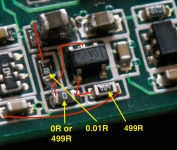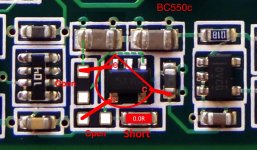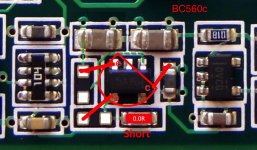The 1021 was a *lot* cheaper than the 1121 before the 1921/41 boards came out. With the 1021 price drop, it's a much more compelling option.
I can’t believe he raised prices on 1021. If anything he should lower prices after so long since release. Speaking of price, Denafrips Ares seems a very economical option.
Here's a measurement of 1021. Soekris DAM1021 R2R DAC Measurements | Audio Science Review (ASR) Forum
Just noticed that it's a rev4, unsure what the resistor precision is since there are fewer blue resistors than on my 0.01/2 version. But it seems to measure well even though the output is after the onboard buffer; I was previously a bit worried about Paul's claim that the buffers unmodded has 0.02% THD. Jitter sideband seems clean too.
Here's 1541's measurement: Soekris dac1541 technical measurements | Super Best Audio Friends
I'll do some measurements on my build with umc202hd this weekend. Any suggestion on test suites?...
Just noticed that it's a rev4, unsure what the resistor precision is since there are fewer blue resistors than on my 0.01/2 version. But it seems to measure well even though the output is after the onboard buffer; I was previously a bit worried about Paul's claim that the buffers unmodded has 0.02% THD. Jitter sideband seems clean too.
Here's 1541's measurement: Soekris dac1541 technical measurements | Super Best Audio Friends
I'll do some measurements on my build with umc202hd this weekend. Any suggestion on test suites?...
Last edited:
I can’t believe he raised prices on 1021. If anything he should lower prices after so long since release. Speaking of price, Denafrips Ares seems a very economical option.
Sorry, I meant 1121 price drop.
Sorry, I meant 1121 price drop.
There is an increase on 1021
Could it be because I connected SE to the negative buffered outputs of the inverted (left) channels to keep SE and BAL independent? Could the inverted output be inferior somehow?
If you listen to a signal with the phase flipped this would matter, since we are able to hear absolute phase. There might be several other factors at play, for one impedance matching skews the results and there might be interference getting into the unbalanced signal that doesn't effect the balanced connection etc.
If you listen to a signal with the phase flipped this would matter, since we are able to hear absolute phase. There might be several other factors at play, for one impedance matching skews the results and there might be interference getting into the unbalanced signal that doesn't effect the balanced connection etc.
It’s inverted and then flipped so should be normal. Phase flipped would probably sound much more different
Hi Soeren,
I'd like to increase the amplitude of main DAM1021 V 5 boards balanced output by 6-7dB. In order to do this I would change the resistors around the first half of the OPA1602 (non-inverting) op amp. I could either increase the resistance of the feedback capacitor to ca. 2.5 k ohm or lower the resistance of the resistor to ground to ca. 300 ohm. The latter would be easier, since I could simply add a resistor in parallel.
What do you recommend? Would this be stable or does it require an additional compensation cap?
Thanks!
I'd like to increase the amplitude of main DAM1021 V 5 boards balanced output by 6-7dB. In order to do this I would change the resistors around the first half of the OPA1602 (non-inverting) op amp. I could either increase the resistance of the feedback capacitor to ca. 2.5 k ohm or lower the resistance of the resistor to ground to ca. 300 ohm. The latter would be easier, since I could simply add a resistor in parallel.
What do you recommend? Would this be stable or does it require an additional compensation cap?
Thanks!
Hi Soeren,
I'd like to increase the amplitude of main DAM1021 V 5 boards balanced output by 6-7dB. In order to do this I would change the resistors around the first half of the OPA1602 (non-inverting) op amp. I could either increase the resistance of the feedback capacitor to ca. 2.5 k ohm or lower the resistance of the resistor to ground to ca. 300 ohm. The latter would be easier, since I could simply add a resistor in parallel.
What do you recommend? Would this be stable or does it require an additional compensation cap?
Thanks!
You can do whatever you want. The best would be to change both, to keep the same impedance on the opamps inputs.
You can do whatever you want. The best would be to change both, to keep the same impedance on the opamps inputs.
Thanks, you mean the resistor on op amp 1 going to ground should be the same value as the series and the feedback resistor on op amp 2, correct?
Thanks, you mean the resistor on op amp 1 going to ground should be the same value as the series and the feedback resistor on op amp 2, correct?
No, the two resistors setting the gain should have the same value as the R-2R network output impedance, 625R, when paralleled, so both the + and - inputs on the opamp see the same resistance. That way you minimize output offset voltage. But the used opamp, the opa1602, already have a pretty low offset current, so it's not that critical. To keep it simple, you can just increase the resistor from output to the - input.
You did in that way?...so 499R-499R-0.01R or 499R-0R-0.01R....That people knows what is important mod that you talk about.
And can anybody make sound result (diffeerence) vs BCxxx -Transistor VREF modification?
And can anybody make sound result (diffeerence) vs BCxxx -Transistor VREF modification?
Attachments
Last edited:
You did in that way?...so 499R-499R-0.01R or 499R-0R-0.01R....That people knows what is important mod that you talk about.
And can anybody make sound result (diffeerence) vs BCxxx -Transistor VREF modification?
Well the guy who invented the 0.01R mod said don't do it. So, don't do it.
Soren said he tested the transistor mod and didn't like the fact that it needs extra current to stay low impedance. But let me know if there's great ABX results from it...
Thank you for explanation, but you are so fast that you can*t answer what was asked ...
So be precise as you are at the whole process.
499-499-0,01R mod or 499R-0R-0,01R mod?
So be precise as you are at the whole process.
499-499-0,01R mod or 499R-0R-0,01R mod?
Thank you for explanation, but you are so fast that you can*t answer what was asked ...
So be precise as you are at the whole process.
499-499-0,01R mod or 499R-0R-0,01R mod?
I think the low-res mod is defined as using 0.01R for the series resistor. 499R and 0R are two variations. I think rev2+ have 499R.
No, the two resistors setting the gain should have the same value as the R-2R network output impedance, 625R, when paralleled, so both the + and - inputs on the opamp see the same resistance. That way you minimize output offset voltage. But the used opamp, the opa1602, already have a pretty low offset current, so it's not that critical. To keep it simple, you can just increase the resistor from output to the - input.
Got it, thanks!
Soren, would a small heatsink on the 3.3V LDO help with the heat imbalance in the LSB of the left channel? Do you think it's beneficial at least theoretically? It's pretty trivial to add for DIY.
Soren, would a small heatsink on the 3.3V LDO help with the heat imbalance in the LSB of the left channel? Do you think it's beneficial at least theoretically? It's pretty trivial to add for DIY.
It's always good to keep temperatures down....
It's always good to keep temperatures down....
Thanks for the quick reply! I thought it's probably better to dissipate heat into the ambient air than PCB. 🙂
One question : is there a new firmware for the 1121? I am at 1.06, and for the 1021 there is a 1.19 for download. Does this work for the 1121 too?
Soundwise the DAC is pretty good now, especially after rewiring the Salas shunts with thicker gauge wire and installing HQplayer, which is easily the best player software so far. Ynmichael, I can't believe you don't hear the difference . And the buffered opamp out is really not convincing btw.
My SD player is still better in some areas, it is more natural and dense in tone and timbre.
The Soekris is more dynamic and has a bigger stage, but still sounds a little forward and shouty sometimes. Wonder how it would behave connected via toslink or with SD card. Maybe this last digital trace would disappear, as I don't trust the USB connection too much...
Soundwise the DAC is pretty good now, especially after rewiring the Salas shunts with thicker gauge wire and installing HQplayer, which is easily the best player software so far. Ynmichael, I can't believe you don't hear the difference . And the buffered opamp out is really not convincing btw.
My SD player is still better in some areas, it is more natural and dense in tone and timbre.
The Soekris is more dynamic and has a bigger stage, but still sounds a little forward and shouty sometimes. Wonder how it would behave connected via toslink or with SD card. Maybe this last digital trace would disappear, as I don't trust the USB connection too much...
- Home
- Vendor's Bazaar
- Reference DAC Module - Discrete R-2R Sign Magnitude 24 bit 384 KHz


